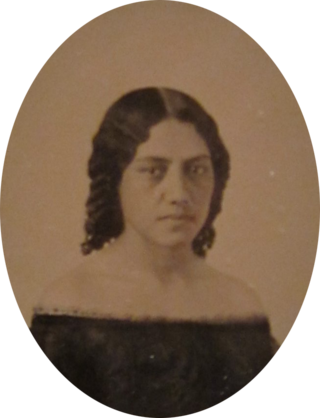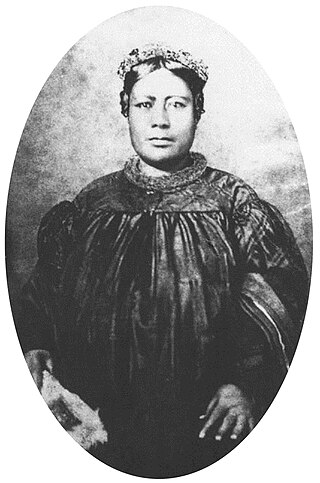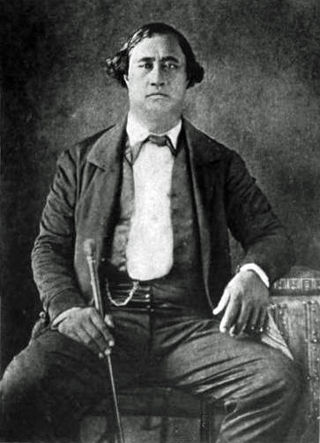
Bernice Pauahi Pākī Bishop KGCOK RoK was an aliʻi (noble) of the Royal Family of the Kingdom of Hawaii and a well known philanthropist. At her death, her estate was the largest private landownership in the Hawaiian Islands, comprising approximately 9% of Hawaii's total area. The revenues from these lands are used to operate the Kamehameha Schools, which were established in 1887 according to Pauahi's will. Pauahi was married to businessman and philanthropist Charles Reed Bishop.

Charles Reed Bishop was an American businessman, politician, and philanthropist in Hawaii. Born in Glens Falls, New York, he sailed to Hawaii in 1846 at the age of 24, and made his home there, marrying into the royal family of the kingdom. He served several monarchs in appointed positions in the kingdom, before its overthrow in 1893 by Americans from the United States and organization as the Territory of Hawaii.

Ruth Ke‘elikōlani, or sometimes written as Luka Ke‘elikōlani, also known as Ruth Ke‘elikōlani Keanolani Kanāhoahoa or Ruth Keanolani Kanāhoahoa Ke‘elikōlani, was a member of the House of Kamehameha who served as Governor of the Island of Hawaiʻi and for a period, was the largest and wealthiest landowner in the Hawaiian islands. Keʻelikōlani's genealogy is controversial. Her mother's identity has never been in question but her grandfather Pauli Kaōleiokū's relationship to Kamehameha I is heavily disputed. While her father has been legally identified as early as 1864, disputes to that lineage continued as late as 1919. As one of the primary heirs to the Kamehameha family, Ruth became landholder of much of what would become the Bernice Pauahi Bishop Estate, funding the Kamehameha Schools.

The House of Kamehameha(Hale O Kamehameha), or the Kamehameha dynasty, was the reigning royal family of the Kingdom of Hawaiʻi, beginning with its founding by Kamehameha I in 1795 and ending with the death of Kamehameha V in 1872 and Lunalilo in 1874. The kingdom continued for another 21 years, until its overthrow in 1893 with the fall of the House of Kalakaua.
Niumataiwalu was a Fijian high chief.

Elizabeth Kekaʻaniau Laʻanui Pratt, full name Elizabeth Kekaʻaniauokalani Kalaninuiohilaukapu Kekaikuihala Laʻanui Pratt, was a Hawaiian high chiefess (aliʻi) and great-grandniece of Kamehameha I, being a great-granddaughter of Kalokuokamaile, the older brother of Kamehameha I, founder of the Kingdom of Hawaii. She was the daughter of Gideon Peleʻioholani Laʻanui and Theresa Owana Kaheiheimalie Rives.

Laura Kanaholo Kōnia was a high chiefess of the Kingdom of Hawaii. She was the mother of Bernice Pauahi Bishop, the founder of Kamehameha Schools.
Jane Loeau was a Hawaiian chiefess during the Kingdom of Hawaii who attended the Chiefs' Children's School, also known as the Royal School.

Abner Kuhoʻoheiheipahu Pākī was a Hawaiian high chief during the reign of King Kamehameha III, the father of Bernice Pauahi Bishop, founder of Kamehameha Schools.
Pauahi (c.1804–1826) was a member of the royal family of the Kingdom of Hawaii in the House of Kamehameha. Referred as Pauahi in her lifetime, she is often referred to as Kalanipauahi or Kalani Pauahi to differentiate her from her niece and namesake Bernice Pauahi Bishop.
Joshua Kaʻeo, was a Hawaiian high chief or nobleman of Hawaii Island descent, the uncle of Queen Emma of Hawaii, and an early Hawaiian politician and advisor of Kamehameha III.

Kinoʻoleoliliha Pitman, also written as Kinoole-o-Liliha, was a high chiefess in the Kingdom of Hawaii. She was known as Mrs. Pitman after her marriage. In the Hawaiian language, kino 'ole means "thin" and liliha can mean "heartsick".
Kaneʻalai was a Queen regnant of the Hawaiian island of Molokai, who lived in the 18th century. She ruled as Alii nui of Molokai.
Kānekapōlei was a Native Hawaiian aliʻi wahine (queen) and wife of Kalaniʻōpuʻu, aliʻi nui of the Island of Hawaii and aunt of Kamehameha I, who were all present at Captain James Cook's death. She called attention to the kidnapping of her husband by Cook and his men, attracting his royal attendants to the beach, answering her calls for help.
Mualani was a Hawaiian High Chiefess who lived on the island of Oahu and was a Princess of Koʻolau.
ʻAkahi was a high chiefess and female landholder of the Kingdom of Hawaii. Also known as "Akahi-a-Kaleiwohi", she was named after her great-grandmother Akahi-a-Kuleana. ʻAkahi was also the name of Akahi-a-Kuleana, the mother of 15th-century Hawaiian king ʻUmi-a-Līloa. A relation of the ruling House of Kamehameha, ʻAkahi was married to Kahekili Keʻeaumoku II and Kalanimoku, two prominent Hawaiian high chiefs and politicians during the early 19th century. She lived most of her life on the island of Hawaii where she was allocated vast landholdings after the Great Mahele of 1848. After her death in 1877, these lands were inherited by her relative Bernice Pauahi Bishop and upon the latter's death became part of the Bernice Pauahi Bishop Estate, which now funds the Kamehameha Schools.

Teuira Henry was a British Tahitian scholar, ethnologist, folklorist, linguist, historian and educator. She worked to reconstruct a lost manuscript on the history of Tahiti written by her grandfather, English missionary John Muggridge Orsmond, by using his original notes. Most of her writings were published posthumously by the Bernice Pauahi Bishop Museum as the book Ancient Tahiti.
Hineuki was a Hawaiian noble lady and Chiefess of the island of Hawaiʻi as the wife of Kukohou, Aliʻi Nui of Hawaiʻi. She was named after the goddess Hina, who was one of the most important deities in the religion of the Ancient Hawaiians.
Kalaikuʻahulu was a kānaka maolialiʻi and kahuna nui of Kamehameha I in pre-Christian Hawaii who was considered a prophet for his prediction of; "Ke Akua maoli" and a message to Hawaiians never seen before. After the arrival of the Christian missionaries in 1820, Kaʻahumanu and others believed the prophecy to be fulfilled. He was also genealogist for Kamehameha, who placed his wives, Kekāuluohi and Hoapiliwahine, under his tutelage as genealogy students.

Bernice Pauahi Fernow was an American miniature painter.









